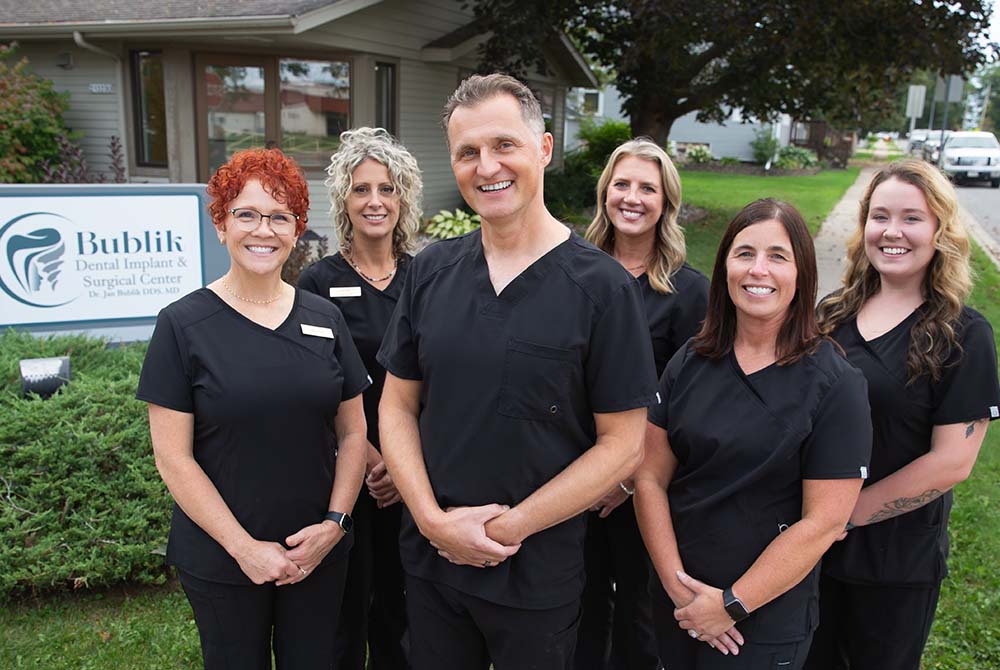There are several ways of how to add more volume to the bone and, you know, if you think about it, your back teeth are a lot bigger than your front teeth. You know, you will need more mass, if you will, of the implants and that needs to be supported by a lot bigger bony area. That’s kind of what we need to decide and work on. We have a 3D technology in our office called a cone beam which is basically a dental CT, so it is a three-dimensional x-ray. That can tell us with, you know, 0.1-millimeter precision, you know, how much available bone you have in the area by your sinus. Do you need to have grafting into your sinus?
I’ve had extensive education in the area of grafting. I’ve worked with, you know, world-renowned oral surgeons in Germany. You know, I have over a thousand hours of continuing education in that and I specialize in my teaching and sharing of my knowledge with my fellow dentists. I specialize at areas of grafting and decisions and what is the best method for which particular case. So you can rest assured when you come to my office, you know, we know exactly what you need and we’ll give you that information right away and, you know, we’ll tell you what the best option, what the most successful outcome we are looking for is. So, you know, I can definitely talk about grafting a long time.
Prepare for Implants With Bone Grafts in Stratford
Restoring your smile with dental implants is a life-changing decision. Your journey often begins by addressing the foundation of your smile. If you spent years with missing teeth or wearing only dentures, it can lead to bone loss in your jaw. In that case, you may need bone grafts in Stratford before you can receive your implants. With Dr. Jan Bublik’s expertise, you will:
- Rebuild and strengthen your jawbone to support implants
- Create a solid foundation for your future smile
- Maintain the natural contours of your face
- Reduce your risk for future bone loss
Call 715-333-3541 for an appointment.
Get One Step Closer to Your Dream Smile With a Grafting Procedure
For you to receive your implants, Dr. Bublik will need to set the stage for your mouth to support them. You can trust that you will receive the best in care when working with him. As an educator and international speaker on dental implant topics, Dr. Bublik stays at the forefront of the latest advancements in the field. He is pursuing his PhD in dental implantology and serves as the Clinical Director of the Restorative Driven Implant Institute. His knowledge and expertise ensure you will have the most successful implant procedure.
Before beginning any treatment, Dr. Bublik will thoroughly examine your jawbone using cutting-edge imaging technology such as 3-D CBCT scans. This allows him to assess the extent of your bone loss. He will determine if you need bone grafting. You may be a candidate for All-on-4 implants. This treatment requires less bone material, possibly eliminating the need for a graft.
If you do need a graft, you can trust in Dr. Bublik’s expertise and gentle approach. The bone grafting process involves:
- Placing specialized material to stimulate new bone growth
- Securing the material in place with only a few sutures
- Allowing your body’s natural healing process to form new, healthy bone tissue
- Scheduling follow-up appointments to monitor your progress and determine your readiness for implant placement
Throughout your treatment, Dr. Bublik will make sure you feel comfortable and informed. He will explain each step of the procedure. In most cases, you’ll be able to get implants within a few months.
Call 715-333-3541 for bone grafts in Stratford.
A bone graft is basically filling in or building up a thin or weak jawbone. A bone graft can fill space left after an extraction, or we can use it to boost the strength of a jawbone battling an infection brought on by gum disease. Your dentist will simply place material along your bone that will encourage new bone growth. While the procedure itself is quick, it will take several months for your bone to respond and heal.
One of the most common reasons for bone grafts is to strengthen a jaw so it can successfully support implants. The more time that has passed since you’ve lost teeth, the more likely you may need a graft to receive implants. Without tooth roots to provide stimulation, the bone in your jaw begins to shrink – as much as 25 percent in the first year after tooth loss.
A bone graft can save teeth you are at risk of losing from periodontal (gum) disease. In advanced cases of gum disease, inflammation can attack the bone surrounding your teeth. A grafting procedure will encourage the bone to regenerate, so you won’t lose teeth. Treating gum disease in its early stages will avoid the need for a graft.

